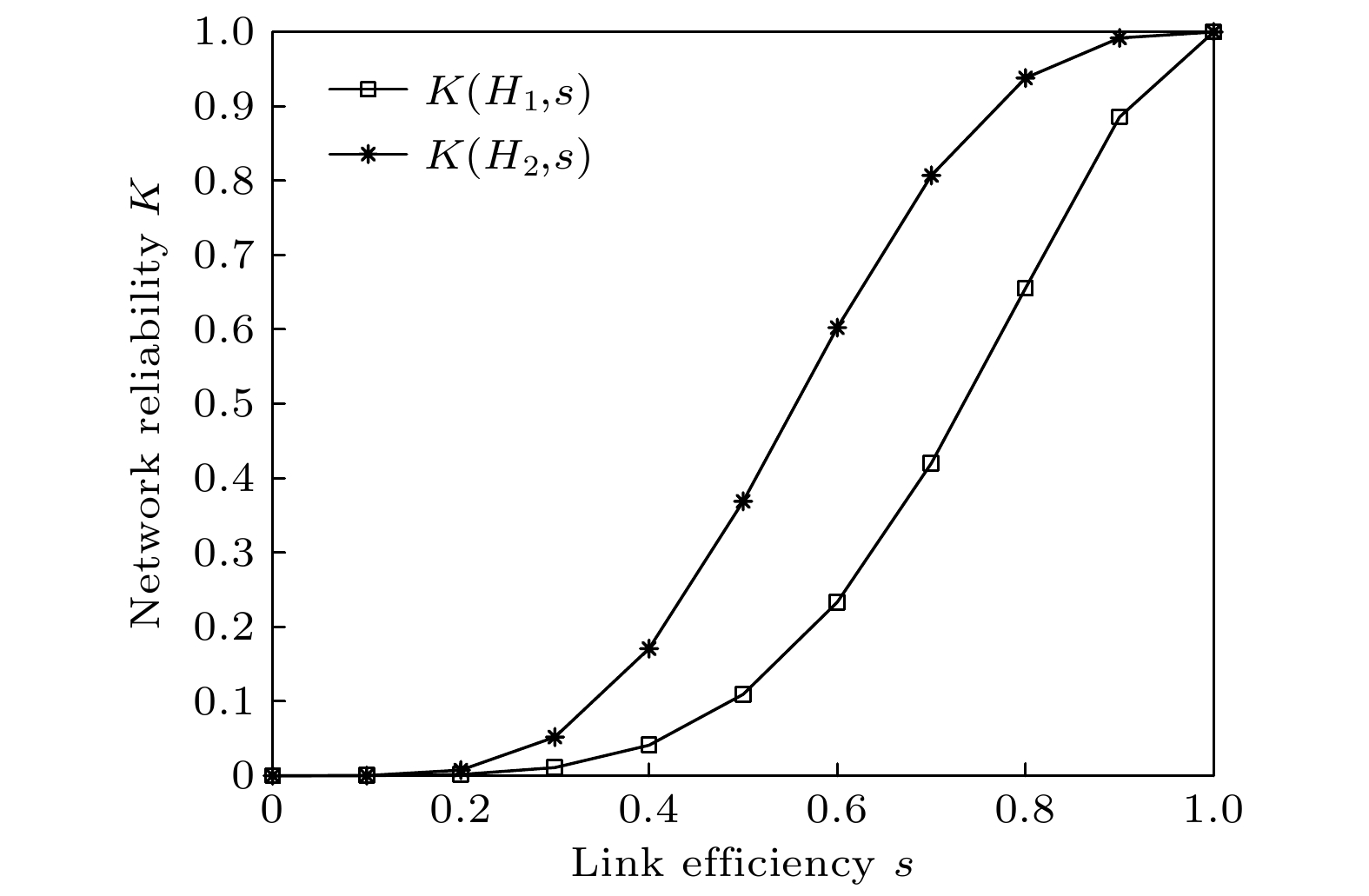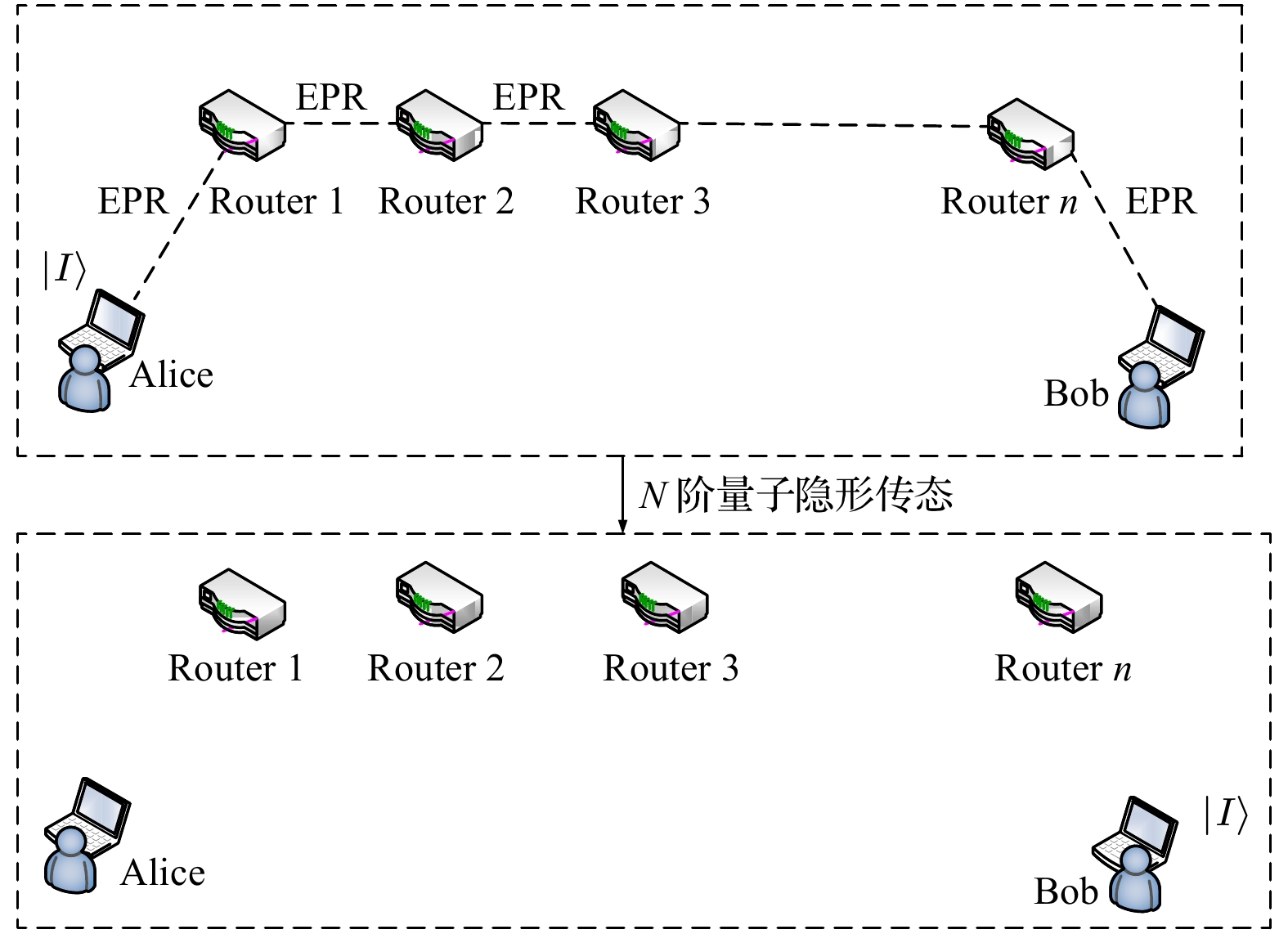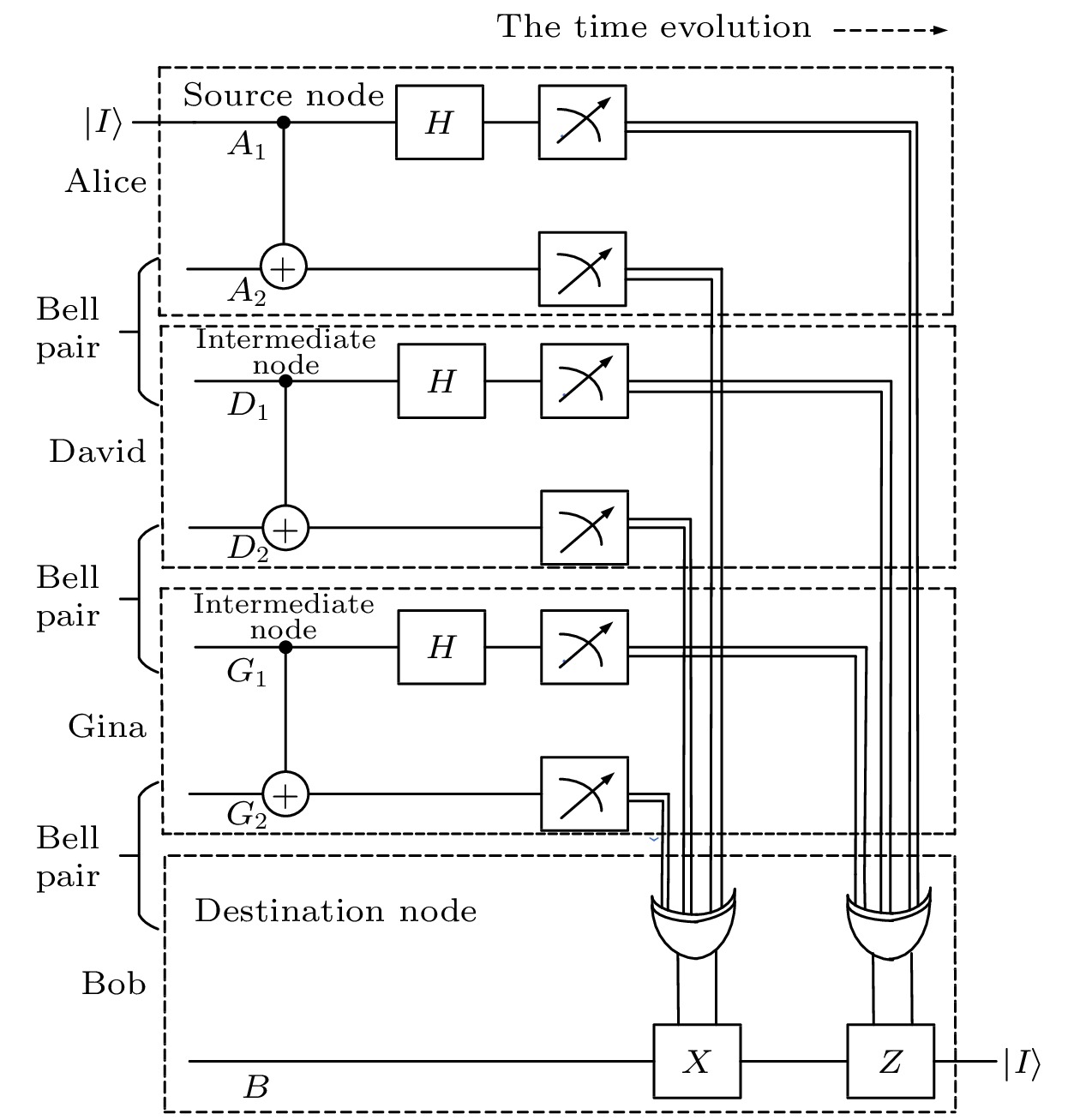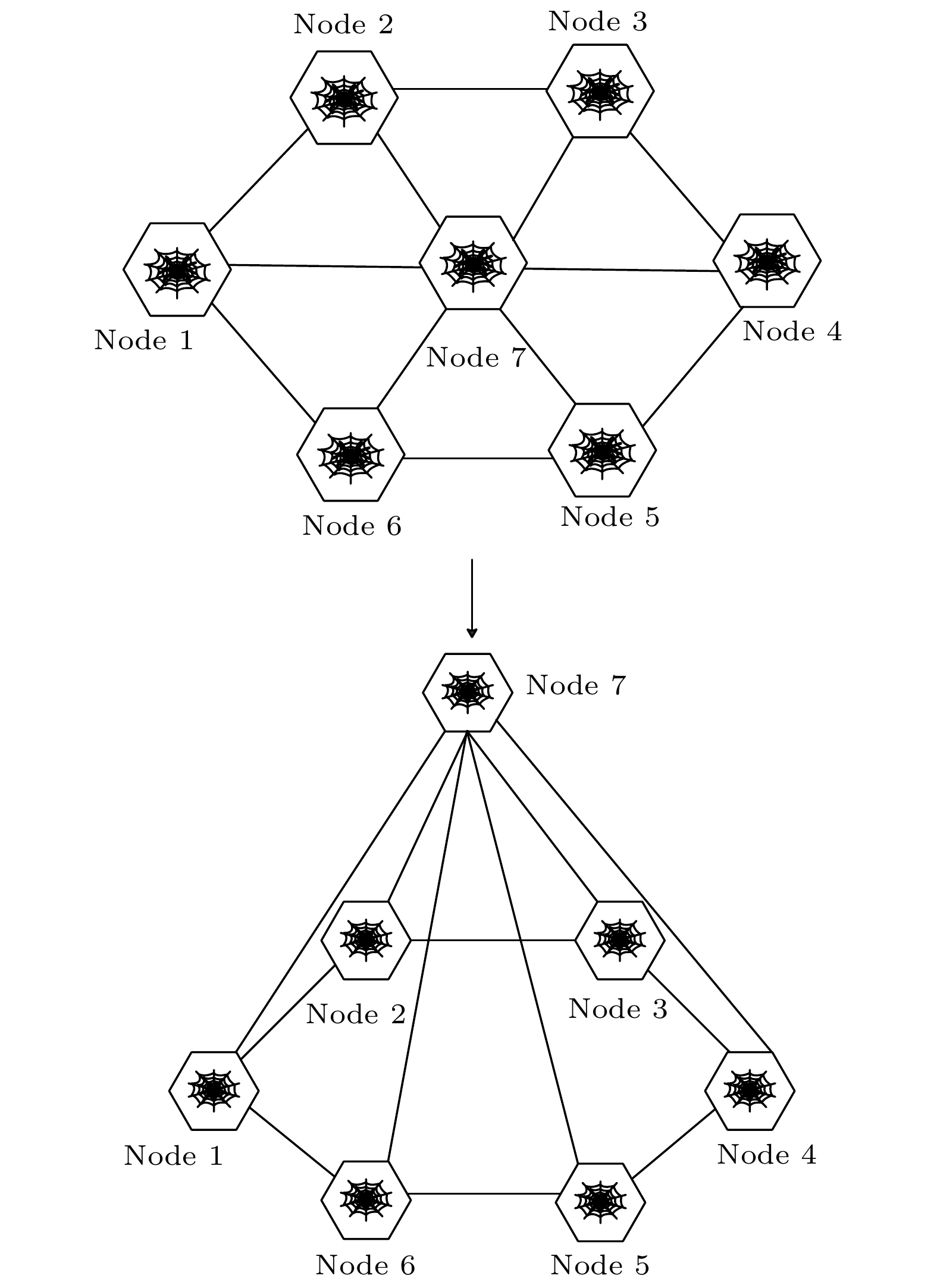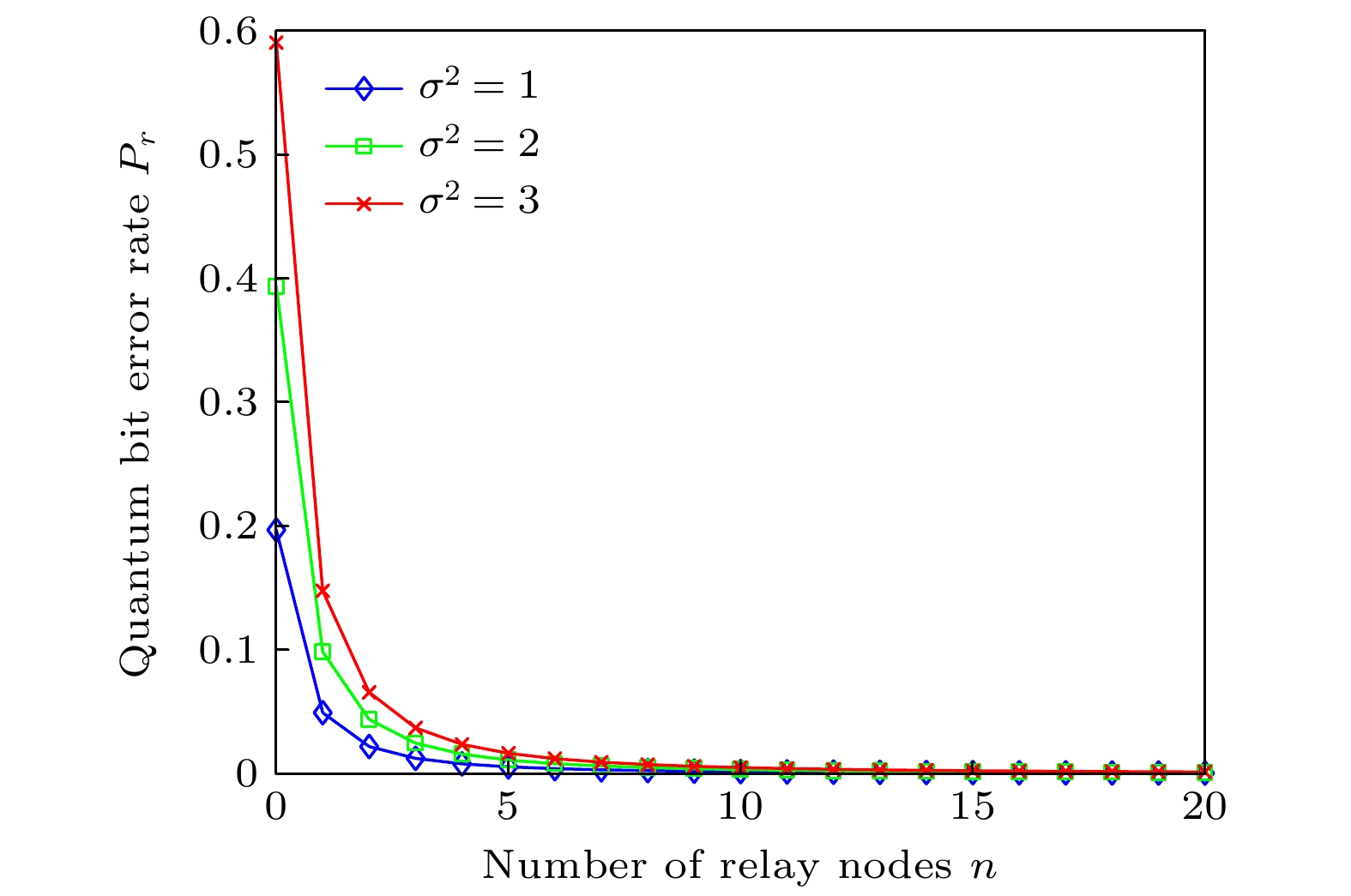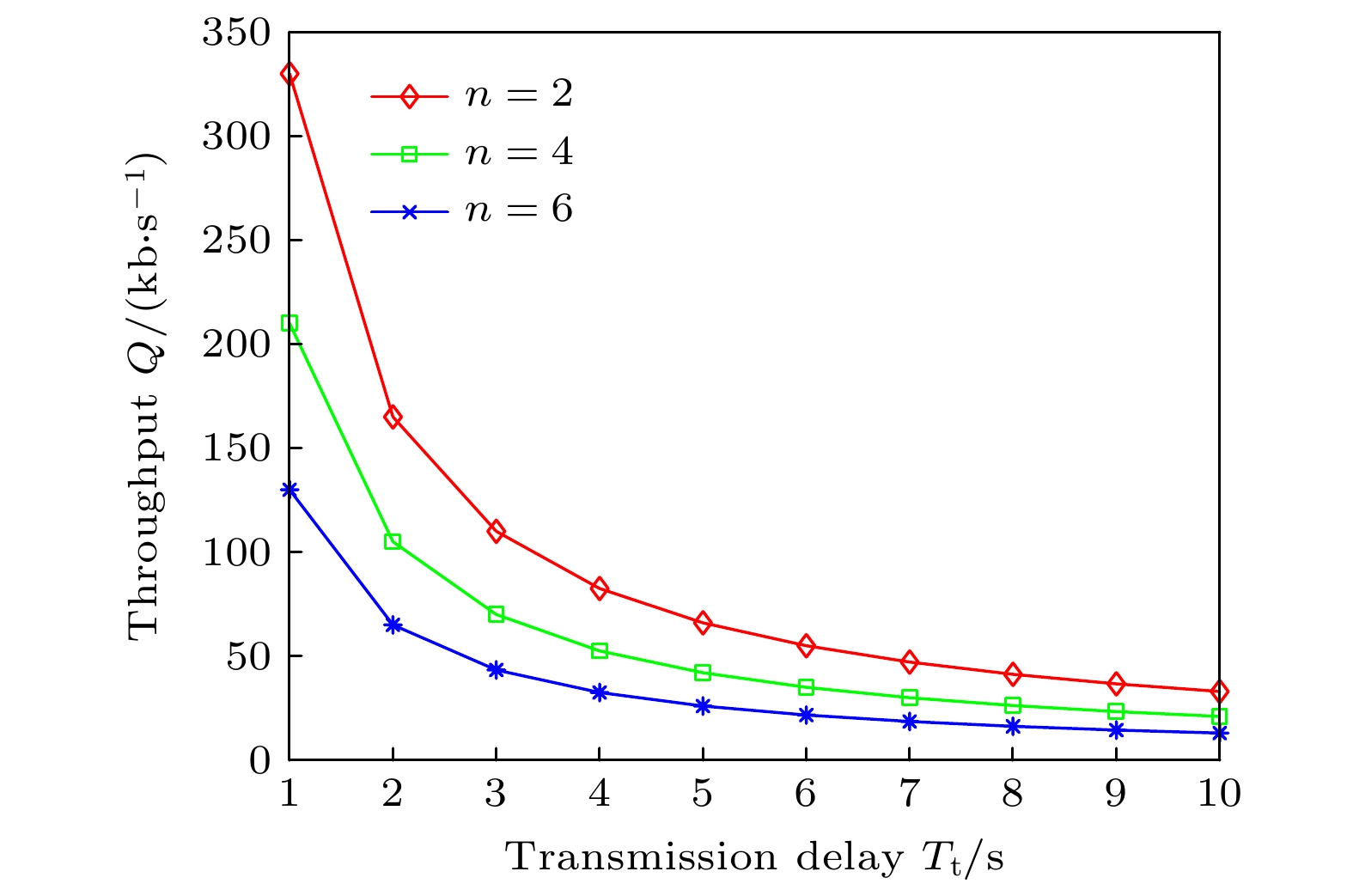-
量子卫星通信是通信领域的研究热点和前沿, 具有理想的信息安全性和覆盖面广的优势, 对于构建全球范围的量子卫星广域网具有重要意义, 而远距离传输信息时网络的可靠性、安全性和路由中继等问题仍需改进. 为了构建性能良好的量子卫星广域网, 本文提出利用蜘蛛网作为一种独特的自然通信拓扑结构, 将自然界蛛网演进为人工蛛网拓扑, 量子信息的传输采用N阶量子隐形传态路由方案, 其传输时延基本不变, 在此基础上构建蛛网网络拓扑量子广域网传输模型, 并对构建的网络模型的误码率、吞吐率、安全密钥生成率进行仿真分析. 用抗毁度作为衡量网络拓扑结构可靠性的指标, 以9节点环型网和9节点蛛网为例进行定量和定性分析, 得出蛛网拓扑具有更高的可靠性. 当噪声的平均功率谱密度给定且不存在中继时, 量子态的传输距离越大误码率越大, 这时要考虑引入中继; 当传输距离和噪声功率谱密度一定的情况下, 误码率随着中继节点个数的增多而减小, 因此在蛛网拓扑下要选择合适的路由过程. 随着量子卫星分发纠缠光子对成功概率的增大, 吞吐率逐渐增加; 随着网络中传输时延的增大, 吞吐率逐渐减小, 但在该路由方案下传输时延基本不变, 且蛛网结构的传输时延很小, 因此本文中提出的基于N阶量子隐形传态的蛛网网络拓扑量子广域网的吞吐率不会有明显的降低. 当量子信息的传输距离不断增大时, 网络密钥生成率逐渐减小; 随着网络中继节点个数的增多, 密钥生成率逐渐增加. 由此可见, 利用蛛网拓扑以及N阶量子隐形传态路由方案构建量子卫星广域网具有很好的优势.
-
关键词:
- 蜘蛛网拓扑 /
- N阶量子隐形传态路由方案 /
- 量子卫星广域网
Quantum satellite communication is a research hotspot and frontier in the field of communication. It has the advantages of ideal information security and wide coverage, which is of great significance in constructing a global quantum satellite wide area network. However, problems such as network reliability, security and routing relay still need to be improved when transmitting information over long distances. In this paper, the spider web is used as a unique natural communication topology to transform the natural spider web into an artificial spider web topology. The quantum information transmission adopts N-order quantum teleportation routing scheme, and the transmission delay is basically unchanged. On this basis, the spider web topology quantum wide area network transmission model is constructed. The bit error rate, throughput rate and security key generation rate of the network model are simulated and analyzed. Taking 9-node ring network and 9-node cobweb for example, the quantitative analysis and qualitative analysis are both conducted in this paper. The results show that the cobweb topology has higher reliability. When the average power spectral density of the noise is given and there is no relay, the bit error rate increases with the transmission distance increasing, so the introduction of relay should be considered. When the transmission distance and noise power spectral density are constant, the bit error rate decreases with the number of relay nodes increasing, so the appropriate routing process should be selected in the spider web topology. With the increase of the probability of transmitting entangled photon pairs, the throughput rate gradually increases. With the increase of transmission delay in the network, the throughput rate Q gradually decreases. However, the transmission delay is basically unchanged in this routing scheme, and the transmission delay of cobweb structure is very small. Therefore, the throughput rate of the topology quantum WAN of cobweb network based on N-order quantum teleportation proposed in this paper will not significantly decrease. When the transmission distance of quantum information increases, the network key generation rate decreases gradually. With the increase of the number of network relay nodes, the key generation rate increases gradually. Thus, it can be seen that using cobweb topology and N-order quantum teleportation routing scheme to construct a quantum satellite WAN has good advantages.-
Keywords:
- spider web topology /
- N-order quantum teleportation routing scheme /
- quantum satellite wide area network
[1] 彭承志, 潘建伟 2016 中国科学院院刊 31 1096
 Google Scholar
Google Scholar
Peng Z C, Pan J W 2016 Bull. Chin. Acad. Sci. 31 1096
 Google Scholar
Google Scholar
[2] 朱武 2016 硕士学位论文 (北京: 北京邮电大学)
Zhu W 2016 M. S. Thesis (Beijing: Beijing University of Posts and Telecommunications) (in Chinese)
[3] Lo H K, Curty M, Qi B 2012 Phys. Rev. Lett. 108 130503
 Google Scholar
Google Scholar
[4] Cao Y, Li Y H, Yang K X, Jiang Y F, Li S L, Hu X L, Maimaiti A, Li C L, Zhang W J, Sun Q C, Liu W Y, Xiao J, Liao S K, Ren J G, Li H, You L X, Wang Z, Yin J, Lu C Y, Wang X B, Zhang Q, Peng C Z, Pan J W 2020 Phys. Rev. Lett. 125 260503
 Google Scholar
Google Scholar
[5] Yin J, Li Y H, Liao S K, Meng Y, Cao Y, Zhang L, Ren J G, Cai W Q, Liu W Y, Li S L, Shu R, Huang Y M, Deng L, Li L, Zhang Q, Liu N L, Chen Y A, Lu C Y, Wang X B, Xu F H, Wang J Y, Peng C Z, Artur K. Ekert, Pan J W 2020 Nature 582 501
[6] 张志会, 马连轶 2018 中国科技论坛 34 1
 Google Scholar
Google Scholar
Zhang Z H, Ma L Y 2018 Forum Sci. Tech. Chin. 34 1
 Google Scholar
Google Scholar
[7] Liao S K, Cai W Q 2018 Phys. Rev. Lett. 120 030501
 Google Scholar
Google Scholar
[8] 周小清, 邬云文, 赵晗 2011 60 040304
 Google Scholar
Google Scholar
Zhou X Q, Wu Y W, Zhao H 2011 Acta Phys. Sin. 60 040304
 Google Scholar
Google Scholar
[9] 连涛, 聂敏 2012 光子学报 41 1251
 Google Scholar
Google Scholar
Lian T, Nie M 2012 Acta Photo. Sin. 41 1251
 Google Scholar
Google Scholar
[10] 刘晓慧, 聂敏, 裴昌幸 2013 62 200304
 Google Scholar
Google Scholar
Liu X H, Nie M, Pei C X 2013 Acta Phys. Sin. 62 200304
 Google Scholar
Google Scholar
[11] 聂敏, 郭建伟, 卫容宇, 杨光, 张美玲, 孙爱晶, 裴昌幸 2021 激光与光电子学进展 57 1
Nie M, Guo J W, Wei R Y, Yang G, Zhang M L, Sun A J, Pei C X 2021 Laser & Optoelect. Prog. 57 1
[12] Chen Y A, Zhang Q, Chen T Y, Cai W Q, Liao S K, Zhang J, Chen K, Yin J, Ren J G, Chen Z, Han S L, Yu Q, Liang K, Zhou F, Yuan X, Zhao M S, Wang T Y, Jiang X, Zhang L, Liu W Y, Li Y, Shen Q, Cao Y, Lu C Y, Shu R, Wang J Y, Li L, Liu N L, Xu F H, Wang X B, Peng C Z, Pan J W 2021 Nature 589 214
[13] 卓春晖, 蒋平, 王昌河, 郭聪 2006 四川动物 26 898
 Google Scholar
Google Scholar
Zhuo C H, Jiang P, Wang C H, Guo C 2006 Sichuan J. Zoo 26 898
 Google Scholar
Google Scholar
[14] 卓春晖 2007 硕士学位论文 (成都: 四川大学)
Zhuo C H 2007 M. S. Thesis (Chengdu: Sichuan University) (in Chinese)
[15] Liu X S, Zhang L, Lin J W 2010 First International Conference on Pervasive Computing, Signal Processing and Applications Harbin, China, September 17–19, 2010 p224
[16] 李彬 2013 硕士学位论文 (西安: 西安电子科技大学)
Li B 2013 M.S. Thesis (Xi’an: Xidian University) (in Chinese)
[17] 赵振峰 2013 硕士学位论文 (哈尔滨: 哈尔滨工业大学)
Zhao Z F 2013 M. S. Thesis (Harbin: Harbin Institute of Technology) (in Chinese)
[18] 刘晓胜, 张良, 周岩, 林建伟, 徐殿国 2012 中国电机工程学报 32 142
 Google Scholar
Google Scholar
Liu X S, Zhang L, Zhou Y, Lin J W, Xu D G 2012 Proc. CSEE 32 142
 Google Scholar
Google Scholar
[19] Bouwmeester D, Pan J W, Mattle K, Manfred E, Weinfurter H, Zeilinger A 1997 Nature 390 575
 Google Scholar
Google Scholar
[20] Chen P, Deng F G, Long G L 2006 Chin. Phys. 15 2228
 Google Scholar
Google Scholar
[21] 朱秋立, 石磊, 魏家华, 朱宇, 杨汝, 赵顾颢 2018 激光与光电子学进展 55 41
Zhu Q L, Shi L, Wei J H, Zhu Y, Yang R, Zhao G H 2018 Laser & Optoelext. Prog. 55 41
[22] 朱畅华, 裴昌幸, 马怀新, 于晓飞 2006 西安电子科技大学学报 6 839
Zhu C H, Pei C X, Ma H X, Yu X F 2006 J. Xidian. Univ. 6 839
[23] 李铁飞, 杨峰, 李伟, 崔树民 2015 电讯技术 55 959
 Google Scholar
Google Scholar
Li T F, Yang F, Li W, Cui S M 2015 Tele. Engin. 55 959
 Google Scholar
Google Scholar
-
表 1 已知测量结果后的量子门操作
Table 1. Quantum gate operation after known measurement results.
$ {A}_{1} $异或$ {D}_{1} $ $ {A}_{2} $异或$ {D}_{2} $ 量子门操作 0 0 无 0 1 X门 1 0 Z门 1 1 X门和Z门 表 2 已知测量结果后的量子门操作
Table 2. Quantum gate operation after known measurement results.
$ {A}_{1} $异或$ {D}_{1} $异或$ {G}_{1} $ $ {A}_{2} $异或$ {D}_{2} $异或$ {G}_{2} $ 量子门操作 0 0 无 0 1 X门 1 0 Z门 1 1 X门和Z门 表 3 量子信息传输误码率各参量含义
Table 3. Meaning of parameters of bit error rate in quantum information transmission.
L n λ $ {f}_{\rm{T}} $ $ {f}_{\rm{R}} $ $ {F}_{\rm{T}} $ $ {F}_{\rm{R}} $ $ {L}_{\rm{P}} $ 星地间传输距离 中继节点个数 光子波长 发送端望远镜孔径 接收端望远镜孔径 发端望远镜传输因子 收端望远镜传输因子 链路损耗 -
[1] 彭承志, 潘建伟 2016 中国科学院院刊 31 1096
 Google Scholar
Google Scholar
Peng Z C, Pan J W 2016 Bull. Chin. Acad. Sci. 31 1096
 Google Scholar
Google Scholar
[2] 朱武 2016 硕士学位论文 (北京: 北京邮电大学)
Zhu W 2016 M. S. Thesis (Beijing: Beijing University of Posts and Telecommunications) (in Chinese)
[3] Lo H K, Curty M, Qi B 2012 Phys. Rev. Lett. 108 130503
 Google Scholar
Google Scholar
[4] Cao Y, Li Y H, Yang K X, Jiang Y F, Li S L, Hu X L, Maimaiti A, Li C L, Zhang W J, Sun Q C, Liu W Y, Xiao J, Liao S K, Ren J G, Li H, You L X, Wang Z, Yin J, Lu C Y, Wang X B, Zhang Q, Peng C Z, Pan J W 2020 Phys. Rev. Lett. 125 260503
 Google Scholar
Google Scholar
[5] Yin J, Li Y H, Liao S K, Meng Y, Cao Y, Zhang L, Ren J G, Cai W Q, Liu W Y, Li S L, Shu R, Huang Y M, Deng L, Li L, Zhang Q, Liu N L, Chen Y A, Lu C Y, Wang X B, Xu F H, Wang J Y, Peng C Z, Artur K. Ekert, Pan J W 2020 Nature 582 501
[6] 张志会, 马连轶 2018 中国科技论坛 34 1
 Google Scholar
Google Scholar
Zhang Z H, Ma L Y 2018 Forum Sci. Tech. Chin. 34 1
 Google Scholar
Google Scholar
[7] Liao S K, Cai W Q 2018 Phys. Rev. Lett. 120 030501
 Google Scholar
Google Scholar
[8] 周小清, 邬云文, 赵晗 2011 60 040304
 Google Scholar
Google Scholar
Zhou X Q, Wu Y W, Zhao H 2011 Acta Phys. Sin. 60 040304
 Google Scholar
Google Scholar
[9] 连涛, 聂敏 2012 光子学报 41 1251
 Google Scholar
Google Scholar
Lian T, Nie M 2012 Acta Photo. Sin. 41 1251
 Google Scholar
Google Scholar
[10] 刘晓慧, 聂敏, 裴昌幸 2013 62 200304
 Google Scholar
Google Scholar
Liu X H, Nie M, Pei C X 2013 Acta Phys. Sin. 62 200304
 Google Scholar
Google Scholar
[11] 聂敏, 郭建伟, 卫容宇, 杨光, 张美玲, 孙爱晶, 裴昌幸 2021 激光与光电子学进展 57 1
Nie M, Guo J W, Wei R Y, Yang G, Zhang M L, Sun A J, Pei C X 2021 Laser & Optoelect. Prog. 57 1
[12] Chen Y A, Zhang Q, Chen T Y, Cai W Q, Liao S K, Zhang J, Chen K, Yin J, Ren J G, Chen Z, Han S L, Yu Q, Liang K, Zhou F, Yuan X, Zhao M S, Wang T Y, Jiang X, Zhang L, Liu W Y, Li Y, Shen Q, Cao Y, Lu C Y, Shu R, Wang J Y, Li L, Liu N L, Xu F H, Wang X B, Peng C Z, Pan J W 2021 Nature 589 214
[13] 卓春晖, 蒋平, 王昌河, 郭聪 2006 四川动物 26 898
 Google Scholar
Google Scholar
Zhuo C H, Jiang P, Wang C H, Guo C 2006 Sichuan J. Zoo 26 898
 Google Scholar
Google Scholar
[14] 卓春晖 2007 硕士学位论文 (成都: 四川大学)
Zhuo C H 2007 M. S. Thesis (Chengdu: Sichuan University) (in Chinese)
[15] Liu X S, Zhang L, Lin J W 2010 First International Conference on Pervasive Computing, Signal Processing and Applications Harbin, China, September 17–19, 2010 p224
[16] 李彬 2013 硕士学位论文 (西安: 西安电子科技大学)
Li B 2013 M.S. Thesis (Xi’an: Xidian University) (in Chinese)
[17] 赵振峰 2013 硕士学位论文 (哈尔滨: 哈尔滨工业大学)
Zhao Z F 2013 M. S. Thesis (Harbin: Harbin Institute of Technology) (in Chinese)
[18] 刘晓胜, 张良, 周岩, 林建伟, 徐殿国 2012 中国电机工程学报 32 142
 Google Scholar
Google Scholar
Liu X S, Zhang L, Zhou Y, Lin J W, Xu D G 2012 Proc. CSEE 32 142
 Google Scholar
Google Scholar
[19] Bouwmeester D, Pan J W, Mattle K, Manfred E, Weinfurter H, Zeilinger A 1997 Nature 390 575
 Google Scholar
Google Scholar
[20] Chen P, Deng F G, Long G L 2006 Chin. Phys. 15 2228
 Google Scholar
Google Scholar
[21] 朱秋立, 石磊, 魏家华, 朱宇, 杨汝, 赵顾颢 2018 激光与光电子学进展 55 41
Zhu Q L, Shi L, Wei J H, Zhu Y, Yang R, Zhao G H 2018 Laser & Optoelext. Prog. 55 41
[22] 朱畅华, 裴昌幸, 马怀新, 于晓飞 2006 西安电子科技大学学报 6 839
Zhu C H, Pei C X, Ma H X, Yu X F 2006 J. Xidian. Univ. 6 839
[23] 李铁飞, 杨峰, 李伟, 崔树民 2015 电讯技术 55 959
 Google Scholar
Google Scholar
Li T F, Yang F, Li W, Cui S M 2015 Tele. Engin. 55 959
 Google Scholar
Google Scholar
计量
- 文章访问数: 8061
- PDF下载量: 75
- 被引次数: 0














 下载:
下载:


